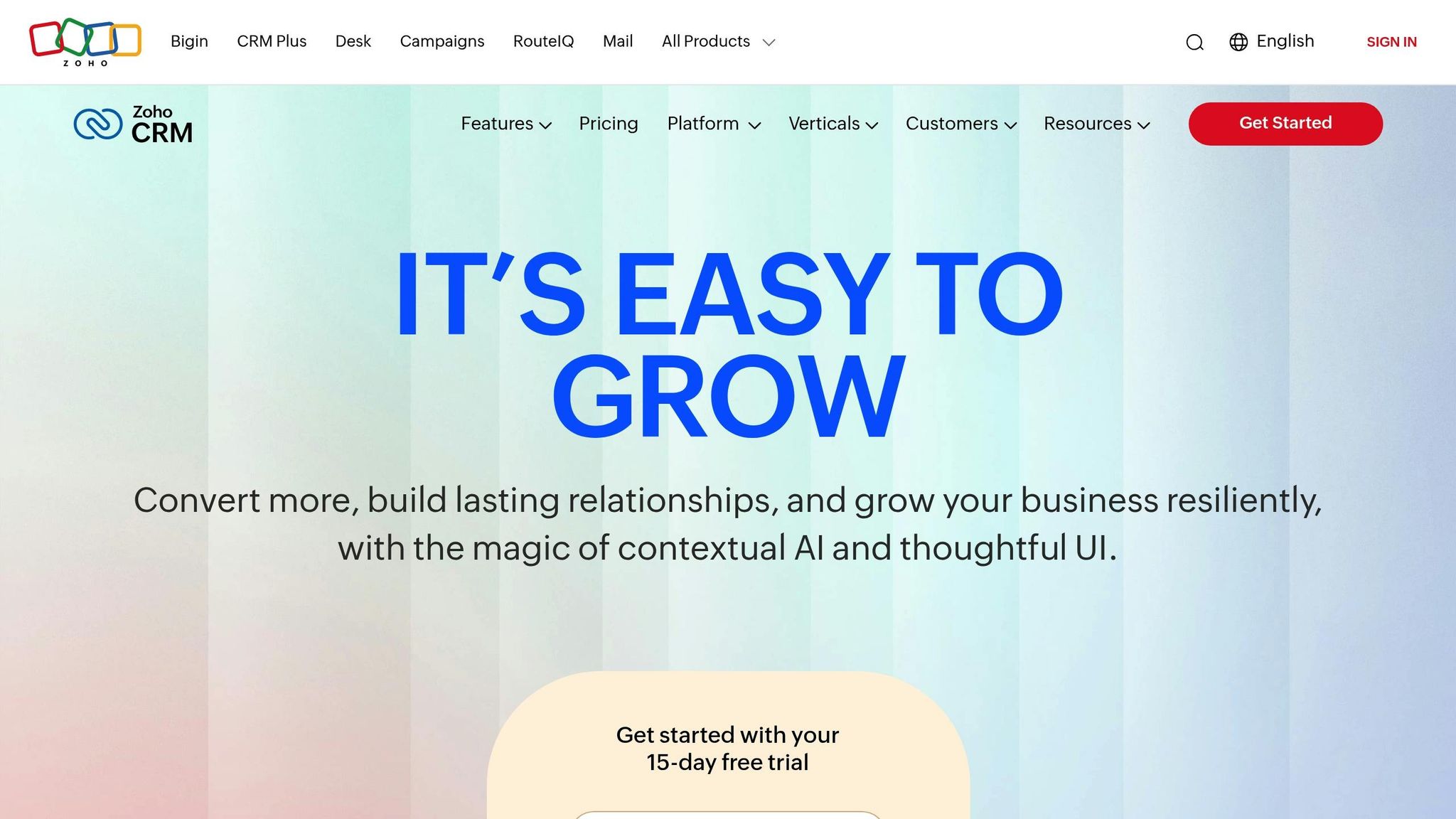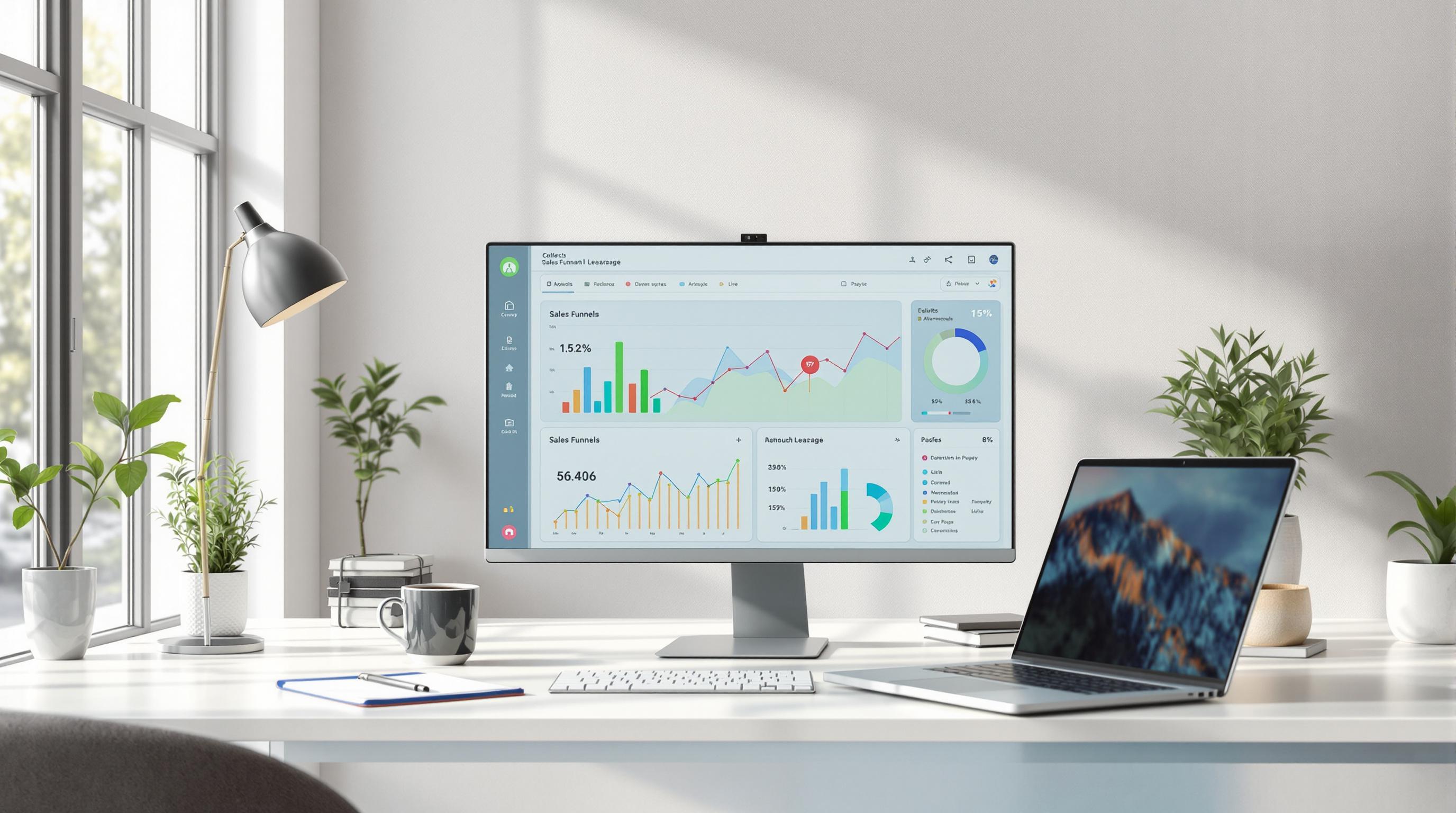CRM API integration connects your CRM system to other tools like marketing platforms, e-commerce solutions, and accounting software. It streamlines workflows, automates data transfers, and ensures customer data is updated in real-time. This allows teams to focus on sales and customer relationships instead of manual data entry.
Key Takeaways:
- Sync customer data instantly for better decision-making.
- Automate processes like lead routing and follow-ups.
- Secure your integration with OAuth 2.0, token management, and role-based access controls.
- Test in a safe environment before going live to avoid disruptions.
- Use modular designs and asynchronous processing to scale as your business grows.
Zoho CRM Developer Series: Zoho CRM APIs - Part 1

Planning and Preparation for Integration
To ensure a smooth and effective CRM API integration, thoughtful planning is key. By setting clear objectives, organizing your data architecture, and outlining thorough testing protocols, you can sidestep common pitfalls and reduce technical risks. This groundwork lays the foundation for the secure and scalable strategies discussed in the following sections.
Define Integration Goals and Business Requirements
Start by identifying specific, measurable goals that align with your organization’s strategic priorities. Engage stakeholders from sales, marketing, and customer service to understand their unique needs. For example:
- Sales teams may want automated lead routing and real-time updates for pipeline management.
- Marketing teams might prioritize seamless synchronization of campaign data.
- Customer service teams often need instant access to complete interaction histories.
Clearly define what success looks like for each department. Whether it’s reducing manual data entry, improving deliverability, or speeding up lead nurturing, your goals should reflect tangible benefits.
Develop a detailed project overview that ties these goals to daily workflows. This ensures all stakeholders understand how the integration will enhance their processes. Additionally, take stock of all current business systems and applications to identify opportunities for automation through the CRM integration.
Document inefficiencies in existing processes and quantify potential improvements. This step not only helps justify the integration’s return on investment (ROI) but also serves as a blueprint for implementing robust API security and performance measures.
Map CRM Fields and Document Custom Objects
A successful integration depends on a thorough audit of your CRM system. Start by identifying all standard and custom fields, data types, and validation rules. Proper field mapping ensures data flows seamlessly between systems.
Pay special attention to custom objects, as they often represent unique business needs that standard CRM fields can’t address. For instance, if your company tracks product warranties separately from deals, you might create a custom warranty object with fields for purchase date, coverage period, and claim status. Carefully define the schema for each custom object, including its name, properties, and relationships to other CRM entities.
Use visual diagrams and concise documentation to illustrate data flows and transformation rules. This is especially important when systems use different data formats. For example, if one system uses MM/DD/YYYY for dates while another uses DD/MM/YYYY, you’ll need transformation logic to avoid errors.
Visual representations of data flows, including intermediate steps and validation checkpoints, can make the integration architecture easier to understand for both technical and non-technical stakeholders. Once your mapping is complete, validate your approach in a controlled environment.
Create a Safe Testing Environment
Testing is critical to ensure your integration works as intended without disrupting real operations.
Set up a dedicated testing environment that closely mirrors your production CRM. This includes replicating custom fields, workflows, user permissions, and sample data. Use realistic test data to simulate actual scenarios while safeguarding sensitive customer information.
Develop comprehensive test cases that cover a range of scenarios, from normal operations to edge cases and error conditions. For instance, test how the system handles failed API calls, mismatched data formats, or exceeded rate limits. These tests help uncover potential issues before they affect live operations.
Use version control for all integration code and configuration files during testing. This practice allows you to track changes, roll back updates if needed, and maintain consistency across development, testing, and production environments.
Finally, plan for data rollback procedures in case issues arise during testing. Documenting these steps ensures you can confidently transition from testing to production without risking data integrity or functionality.
Security and Authentication Best Practices
Protecting your CRM system isn’t optional - it’s a necessity. These systems house sensitive customer data, financial records, and vital business intelligence. A security breach doesn’t just cost money; it can permanently damage customer trust. Here’s how to keep your CRM integrations secure.
Use Secure Authentication Methods
Start with OAuth 2.0, the gold standard for API authentication. It uses temporary access tokens that automatically expire, reducing the risk of credential theft. For server-side applications, always go with the authorization code flow rather than the implicit flow. Pair this with a client secret to secure the token exchange process.
For internal integrations, API keys are commonly used. However, treat them as sensitive credentials. Never embed API keys in client-side code. Instead, store them securely in environment variables or key management services.
Adding multi-factor authentication (MFA) is another layer of protection. Even if primary credentials are compromised, MFA makes unauthorized access far more difficult.
If you’re working with microservices, consider JSON Web Tokens (JWT). JWTs encode user information and permissions, allowing stateless authentication without constant database lookups. Their digital signatures ensure security throughout the process.
Apply the Principle of Least Privilege
A key security practice is the principle of least privilege. This means granting access only to what’s absolutely necessary for a specific integration to function. This approach minimizes the damage in case credentials are compromised.
Start by setting up role-based access controls that match your business needs. For instance, a marketing tool might only need read access to contact and campaign data, but it shouldn’t have permission to delete accounts or access financial records.
Use scope limitations to define what each integration can access. For example, if an integration only syncs contact information, don’t give it access to deal records or reporting data. Most modern CRM APIs allow for detailed, granular permissions.
Regular audits of API permissions are essential. Review permissions quarterly and remove access for deprecated integrations immediately. Keep a clear record of who has access to what data and why.
Finally, avoid using a single "master" API key for multiple integrations. Instead, create separate API credentials for each integration. This isolation simplifies tracking usage, identifying issues, and revoking access when necessary.
Token Management Strategies
Even with secure authentication, effective token management is critical. Access tokens should expire within 1 to 24 hours to limit the risk if they’re compromised. Enable automatic token refresh and rotate refresh tokens regularly. Each time a new access token is issued, replace the refresh token as well.
Ensure tokens are stored securely - never as plain text. Use encryption and secure storage solutions like AWS Secrets Manager or Azure Key Vault. These services offer built-in encryption and access logging.
Prepare for emergencies with token revocation procedures. Your CRM API should allow for immediate invalidation of tokens, and these procedures should be tested regularly to ensure they’re effective.
Monitoring token usage patterns can help detect suspicious activity. Watch for unusual access times, locations, or request volumes. Set up automated alerts for anomalies and have response plans ready.
Finally, log all authentication events, including successful logins, failed attempts, and token usage. These logs are invaluable for security investigations and identifying vulnerabilities. Attach expiration metadata to tokens to ensure timely renewals and avoid interruptions caused by expired credentials.
API Performance and Reliability Optimization
Ensuring top-notch performance is crucial when it comes to CRM integrations. Start by implementing real-time data synchronization - this ensures that every new lead submission instantly updates the CRM. The result? Faster updates and quicker decision-making. Additionally, focus on error handling and monitoring to boost reliability. These steps help catch issues early and keep everything running smoothly.
sbb-itb-b22f30c
Documentation, Maintenance, and Scalability
Ensuring a successful CRM API integration requires a strong focus on documentation, ongoing maintenance, and scalability planning. These steps build on earlier planning and security efforts, helping your integration remain reliable and adaptable as it grows.
Documentation Practices
Good documentation is the backbone of seamless issue resolution. Start by mapping every data flow in detail. This includes outlining field synchronization, data transformation processes, and sync triggers.
Make sure to document field mappings thoroughly - covering data types, validation rules, and any custom formatting. For instance, note if phone numbers are standardized to a format like (XXX) XXX-XXXX before entering the CRM or if lead scores above 80 automatically assign leads to senior sales representatives.
It’s also important to document the reasoning behind decisions, such as why certain fields were excluded or why specific validation rules were applied. This added context will be a lifesaver when team members need to revisit or modify the integration months - or even years - down the line.
Another key element is maintaining an error code reference guide. Include clear explanations for error messages and step-by-step troubleshooting instructions. For example, provide solutions for scenarios like "Contact already exists" or "Required field missing." This guide will save time and reduce frustration when issues arise.
Once your documentation is in place, you’ll be better prepared to tackle API versioning and updates.
Version Control and Updates
CRM APIs are constantly evolving, and keeping up with these changes requires a solid version management plan. Always know which API version your integration is using, and keep an eye on your CRM provider’s release notes for updates. Most enterprise CRM systems offer a 12-18 month notice before deprecating old API versions, giving you plenty of time to adjust.
Before rolling out updates in your live environment, establish a testing protocol. Use a staging environment that mirrors your production setup to test new API versions. Pay close attention to changes in authentication, required fields, or response formats that could disrupt your integration.
Backward compatibility is critical, especially when managing multiple integrations. Design your system to handle API transitions gradually. For instance, use wrapper functions that adapt to different API versions, allowing you to update specific components without overhauling the entire integration.
Set up automated monitoring to track API deprecation notices and updates. Many CRM providers offer webhooks or RSS feeds for announcements. Configure alerts so your team is immediately informed of any significant changes.
By staying on top of version control, you’ll be ready to implement scalable solutions for growing data needs.
Scalability Strategies for Growing Data
As your business grows, your integration must scale to handle larger data volumes. For example, an integration managing 1,000 contacts today may need to handle 100,000 - or more - in the future. A modular architecture offers the flexibility to scale specific components without overhauling the entire system.
Adopt microservices principles by breaking your integration into independent modules. For instance, separate lead imports, contact updates, and opportunity syncing into distinct processes. This allows you to scale high-demand functions without affecting smaller ones.
To manage increasing data volumes, asynchronous processing is essential. Instead of processing every API call immediately, queue requests and handle them in batches during off-peak times. This approach reduces the risk of hitting rate limits and keeps the system stable.
Be smart about filtering data. Sync only records that have been modified since the last update, using timestamps and change tracking to streamline the process.
Optimize your database to support scalability. Index frequently queried fields, archive outdated records, and apply data retention policies to prevent your database from becoming bloated. For larger datasets, consider partitioning tables by date or region to improve query performance.
Prepare for horizontal scaling by designing your system to operate across multiple servers. Use load balancers to distribute API requests evenly and implement database clustering to ensure high availability. This setup will help your integration handle sudden traffic spikes without disruptions.
Finally, keep a close eye on performance metrics to identify potential bottlenecks before they impact users. Monitor API response times, database query speeds, and memory usage. Set up alerts for when performance metrics exceed acceptable thresholds, so you can address issues proactively.
Common Challenges and Solutions in CRM API Integration
Even with careful planning, CRM API integrations can hit unexpected snags. These issues can throw off schedules and frustrate teams, but most challenges follow familiar patterns with well-established solutions. Below, we’ll explore common hurdles and practical ways to address them.
Fixing Data Mapping Errors
Data mapping errors often occur when field types don’t match, required fields are missing, or formats are incompatible. For instance, one system might use the date format MM/DD/YYYY, while your CRM expects YYYY-MM-DD. These mismatches can lead to failed data transfers.
To tackle this, implement field validations to verify data types, formats, and required fields before sending data. For example, ensure phone numbers include only numbers and acceptable characters, and validate email addresses using regex patterns to confirm proper structure.
For format mismatches, deploy data transformation layers. These functions can reformat data to meet your CRM’s requirements. For example, if your CRM expects currency values as integers (e.g., 2500 for $25.00), create a function to multiply decimal values by 100 and strip out currency symbols.
Another tip: test with diverse datasets. Many integrations work fine with clean sample data but fail when real-world complexities - like names with special characters or addresses with apartment details - come into play.
Continuous monitoring is key to catching mapping errors early. Set up alerts for failed API calls and review error logs weekly. Look for recurring issues - for example, if imports frequently fail on the "company_size" field, tweak your validation rules accordingly.
When errors happen, use fail-safe processing to avoid halting the entire sync. Log problematic records for manual review while allowing the rest of the data to process. Store failed records in a separate queue for retries or corrections later.
Handling API Deprecations and Changes
API updates can disrupt integrations overnight. CRM providers regularly modify their APIs, deprecate endpoints, or change response formats, leaving your integration vulnerable if you’re unprepared.
Stay ahead by subscribing to developer updates from your CRM provider. Many platforms offer newsletters, changelogs, or Slack channels for API announcements. Set reminders to check these resources monthly, even if everything seems fine.
Version pinning can help maintain stability. Instead of defaulting to the "latest" API version, specify exact version numbers in your code. While this prevents sudden breaks, you’ll need a plan to upgrade before older versions are deprecated.
To make updates easier, use wrapper functions. These act as intermediaries between your code and the API, so if the API changes, you only need to update the wrapper instead of combing through your entire codebase.
Set up automated testing to catch breaking changes quickly. Daily tests should verify key functions like authentication, data retrieval, record creation, and updates. This way, you’ll spot issues within 24 hours instead of weeks later.
During transitions, fallback strategies are essential. Support both old and new API versions during deprecation periods, and use feature flags to switch between them. If the new version causes problems, you can roll back instantly.
When updates are announced, assess their impact immediately. Prioritize changes based on business importance - authentication updates should be addressed right away, while minor response format tweaks can wait for the next maintenance window.
Deployment Readiness Checklist
A solid pre-deployment checklist can prevent most integration disasters. Building on your earlier testing and documentation, this step ensures nothing critical is overlooked in the rush to go live.
Start by verifying API credentials, permissions, and data validation using real samples. Test authentication renewal processes to avoid failures weeks later when tokens expire.
Error handling should be rigorously tested. Simulate various error conditions - like network timeouts, invalid data, or hitting rate limits - and confirm your integration handles them gracefully. Ensure error notifications reach the right people with enough detail for quick fixes.
Set performance benchmarks to establish baseline expectations. Measure operation times in staging and configure alerts for significant slowdowns in production. Document expected processing times for different data volumes.
Prepare rollback procedures in case something goes wrong. Know how to quickly disable the integration, stop automated processes, and revert to manual workflows if needed. Test these procedures beforehand to avoid scrambling during an emergency.
Configure monitoring and alerting systems before going live. Set alerts for failed API calls, unusual error rates, and performance dips.
Don’t forget user training and communication. Make sure your team understands how the integration works, what to expect, and how to report issues. Provide simple troubleshooting guides for common problems users might face.
Lastly, have a data backup and recovery plan in place. Test your backup procedures and document the steps for restoring data if something goes wrong, like accidental deletions or corruption caused by the integration.
Schedule the deployment during a low-activity window, such as midweek, when your team can closely monitor the system and respond quickly to issues. Avoid Mondays, Fridays, or times when key team members are unavailable. Plan for at least 24 hours of active monitoring post-deployment to catch any lingering problems.
Conclusion
Achieving a successful CRM API integration hinges on four key elements: planning, security, performance, and scalability. Together, these pillars create a foundation that supports long-term functionality and value.
Planning lays the groundwork by setting clear goals and ensuring detailed field mapping. This step simplifies the integration process and minimizes potential hiccups. Meanwhile, security protects sensitive data through measures like OAuth 2.0 authentication, the principle of least privilege, and proper token management. A single breach can undo years of trust, so prioritizing security is non-negotiable.
On the performance side, techniques like real-time syncing and strategic caching ensure smooth operations, even as demands increase. Scalability ensures that as your business grows, your integration can handle the added complexity without breaking a sweat.
Tools and platforms designed with integration in mind can make a world of difference. Take Hatrio Sales as an example. It simplifies integration challenges by offering automation workflows, access to extensive databases, and features like lead enrichment and scoring. These capabilities reduce the complexity of connecting systems while providing the flexibility needed to support business growth.
It’s also important to remember that integration isn’t a one-and-done task. Regular monitoring, keeping documentation up to date, and adapting to API changes are essential for maintaining a seamless connection. The best integrations are the ones you don’t even notice - they just work, allowing your team to focus on what truly matters: nurturing relationships and closing deals.
FAQs
What are the key steps to successfully plan a CRM API integration?
To successfully integrate a CRM API, begin by setting clear goals. Determine what you want to accomplish - whether it's streamlining data flow or automating repetitive tasks. Having a defined purpose will guide the entire process.
Next, take a close look at your existing tech stack. Ensure the tools you select are compatible with your current systems and can work seamlessly together. Compatibility is key to avoiding unnecessary headaches down the road.
Think ahead by planning for scalability. Even if your immediate needs are simple, design the integration with growth in mind. A flexible setup will save you both time and resources as your business evolves.
Lastly, map out a detailed roadmap. This step helps align all stakeholders, keeps everyone on the same page, and identifies potential challenges early, so you can tackle them proactively.
What are the best ways to secure CRM API integrations and safeguard customer data?
To keep CRM API integrations secure and protect sensitive customer information, businesses need to follow strong security practices. Start with reliable authentication protocols like OAuth 2.0. Ensure data is encrypted both during transmission (using TLS 1.3) and when stored (with AES-256 encryption). Restrict API access by adhering to the principle of least privilege, granting only the permissions necessary for specific tasks.
It's also important to keep an eye out for suspicious activity. Use API gateways to centralize and strengthen security measures, and conduct regular security audits to uncover and fix any vulnerabilities. These steps go a long way in protecting customer data and maintaining the reliability of your CRM system.
What are the best strategies for managing large data volumes and ensuring scalability in CRM API integrations?
To handle large data volumes and support growth in CRM API integrations, it's crucial to design a system that can scale effortlessly with increasing demands. Start by creating a scalable architecture capable of adapting to growing user and data needs. One effective approach is to use dynamic batch processing, which streamlines data transfers by grouping them into manageable chunks. Pair this with a cloud-based infrastructure built on microservices to allow for flexible and efficient scaling.
Incorporate horizontal scaling techniques, such as load balancing, to evenly distribute workloads and prevent bottlenecks. To further enhance performance, consider strategies like caching, query optimization, and parallel processing. These methods can significantly reduce response times, ensuring your CRM system remains fast and reliable as it expands.



